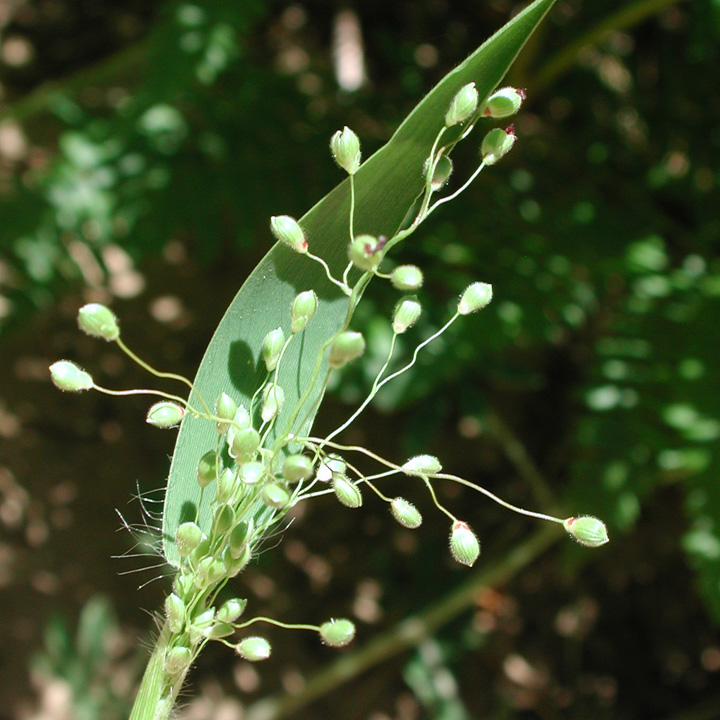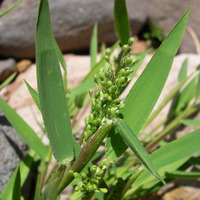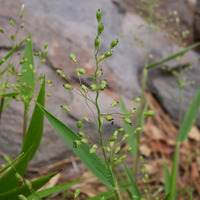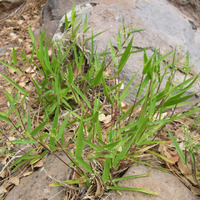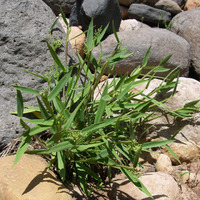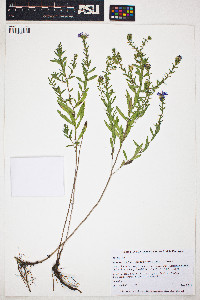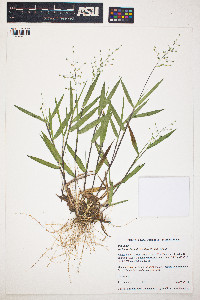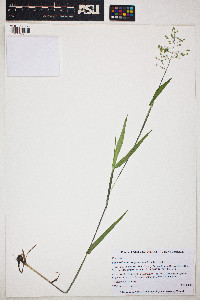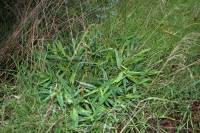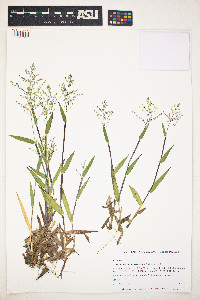|
|
|
|
Family: Poaceae
Heller's rosette grass, more...Heller's rosette grass, Scribner's rosette grass
[Dichanthelium oligosanthes (Schult.) Gould, moreDichanthelium oligosanthes var. helleri (Nash) Mohlenbr., Dichanthelium oligosanthes var. oligosanthes , Dichanthelium oligosanthes var. scribnerianum (Nash) Gould, Panicum helleri Nash, Panicum oligosanthes var. helleri (Nash) Fernald, Panicum oligosanthes var. scribnerianum (Nash) Fernald, Panicum scribnerianum Nash] |
Plants cespitose, with caudices. Basal rosettes well-differentiated; blades 2-6 cm, few, ovate to lanceolate. Culms 20-75 cm, geniculate basally, stiffly erect distally; nodes glabrous or sparsely pubescent; internodes often purplish, glabrous, puberulent, or papillose-hirsute; fall phase branching from the midculm nodes, branches initially ascending to erect, sometimes developing simultaneously with and overtopping the primary panicles, later rebranching to form short, bushy clumps of blades and small, included secondary panicles. Cauline leaves 5-7; sheaths not overlapping, glabrous, puberulent, or ascending papillose-hispid, margins ciliate, collars loose, puberulent; ligules 1-3 mm, of hairs; blades 5-12 cm long, 4-15 mm wide, flat or partly involute, glabrous or pubescent abaxially, with 7-9 major veins only slightly more prominent than the minor veins, bases ciliate, rounded to truncate, margins cartilaginous. Primary panicles 5-9 cm long, 3-6 cm wide, partly enclosed to long-exserted, with 6-60 spikelets; branches stiff or wiry, puberulent or scabridulous. Spikelets 2.7-4.2 mm long, 1.7-2.4 mm wide, ellipsoid to broadly obovoid, turgid, glabrous or sparsely pubescent. Lower glumes 1-1.6 mm, acute, similar in texture and vein prominence to the upper glumes; upper glumes strongly veined, often orange to purplish at the base; lower florets sterile; upper florets with minutely umbonate apices. 2n = 18. Dichanthelium oligosanthes grown throughout the southern portion of the Flora region, and extends into northern Mexico. The primary panicles are briefly open-pollinated, then cleistogamous, from late May to early June; the secondary panicles, which are produced from June to November, are cleistogamous. The subspecies intergrade in areas of overlapping range, but they are usually distinct elsewhere. Specimens of Dichanthelium oligosanthes that have few elongated internodes, but those elongated more than usual, are often mistaken for D. wilcoxianum. Unlike that species, however, they have turgid spikelets with an orange spot at the base of the lemma, indicating that they belong to D. oligosanthes. Such specimens seem to be most common among collections made in the southern and southwestern states during November, February, or March. Sterile hybrids with Dichanthelium acuminatum have often been called Panicum scoparioides Ashe. Apparent hybrids with D. malacophyllum, D. ovale, and D. acuminatum subsp. columbianum are occasionally found. Culms loosely clustered, few-several, erect or ascending, 2-7 dm, often purplish, densely pubescent to glabrous; sheaths occasionally glabrous, sometimes papillose, more often papillose-pilose with ascending hairs; ligule a band of hairs 1-2 mm; blades spreading, lanceolate, glabrous or rarely sparsely papillose-pilose above, glabrous to softly hairy or sparsely papillose-pilose beneath, usually papillose-ciliate and densely long-hairy at base, the larger 6-12 cm נ7-12 mm; primary panicle short-exsert (to 5 cm), becoming long-exsert in age, ovoid, 5-10 cm; spikelets glabrous or minutely villosulous, with broad, heavy veins, turgid, broadly ellipsoid to obovoid, 2.7-4 mm; first glume two- fifths as long, broadly ovate; second glume and sterile lemma subequal, barely equaling the fr; autumnal phase sparsely branched, chiefly from the middle and upper nodes, forming loose bunches, the blades not much reduced, surpassing the few-fld panicles; 2n=18. Dry or moist, often sandy soil, open woods, and prairies; Me. to Fla., w. to Wyo. and Tex., and in the Pacific states. Highly variable, but not clearly divisible into vars. (P. helleri; P. scribnerianum; Dichanthelium o.) Gleason, Henry A. & Cronquist, Arthur J. 1991. Manual of vascular plants of northeastern United States and adjacent Canada. lxxv + 910 pp. ©The New York Botanical Garden. All rights reserved. Used by permission. FNA 2003, Cronquist et al. 1977, Kearney and Peebles 1969 Common Name: Heller?s rosette grass Duration: Perennial Nativity: Native Lifeform: Graminoid General: Tufted perennial with well-differentiated basal rosettes, stems 20-50 cm tall, geniculate basally, stiffly erect above, internodes lustrous, glabrous to sparsely papillose hispid. Vegetative: Blades 6-15 cm long, 4-9 mm wide, less than 10 times longer than wide, flat, ascending to spreading, usually glabrous or sparsely pubescent below acute, with cartilaginous margins; ligules 2-3 mm of hairs. Inflorescence: Dense panicles 5-9 cm long, 3-6 cm wide, partly enclosed to long-exserted with 6-60 spikelets, flexuous branches, spikelets usually 2.5-3.5 mm long, 2-2.5 mm wide,broadly obovoid ellipsoid, usually glabrous; lower glumes 1-1.5 mm, acute, upper glumes strongly veined with a prominent orange to purplish spot at base. Ecology: Found in dry, open oak or pine woodlands often in sandy to clayey soils from 4,000-6,000 ft (1219-1829 m); flowers June-September. Notes: Ours is thought to be var. scribnerianum. Ethnobotany: Thought poisonous to horses. Etymology: Dichanthelium is from Greek dicha for bifid, and stemma a garland or crown, referring to the forked stamens, while oligosanthes means few flowered. Synonyms: Panicum oligosanthes, many others see Tropicos Editor: SBuckley, 2010 |


